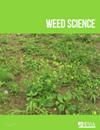生长素相关化合物对野生萝卜2,4- d抗性的化学防治研究
IF 2.5
2区 农林科学
Q2 AGRONOMY
引用次数: 0
摘要
摘要:人工合成的生长素除草剂在其作用方式被明确阐明之前已被开发和商业化了60年。虽然抗氧化性除草剂的进化比其他化学除草剂的进化要慢,但它已成为世界上许多种植区双子叶杂草的一个主要问题。随着2000年代中期对生长素感知和信号通路的分子特征的研究,人们对生长素类除草剂如何起作用,以及在反复选择这些除草剂的杂草中如何产生抗性有了更深入的了解。在澳大利亚南部的野生萝卜(Raphanus raphanistrum L.)种群中,对多种除草剂的抗性,包括合成生长素(如2,4- d),减少了可用的化学防治选择的数量。本研究的目的是确定参与生长素生物合成,运输和信号传导的化合物是否能够与2,4- d协同作用,并提高其控制2,4- d抗性的能力。虽然与一些化合物(脱落酸、环苯胺、色胺)观察到一些轻微的协同作用,但反应不够大或一致,不足以保证进一步的研究。同样,在出苗前或出苗后施用其他抗氧化除草剂并不比2,4- d更有效。因此,虽然由于采用转基因抗性作物,抗氧化除草剂的使用继续增加,但非化学控制技术将变得更加重要,对2,4- d抗性的raphanistrum进行化学控制应采用替代的作用方式,使用混合物和良好的管理,以尽可能长时间地延缓抗性的发展。本文章由计算机程序翻译,如有差异,请以英文原文为准。
Exploring chemical control of 2,4-D-resistant wild radish (Raphanus raphanistrum) with auxin-related compounds
Abstract Synthetic auxin herbicides were developed and commercialised sixty years before their mode of action was definitively elucidated. Although evolution of resistance to auxinic herbicides proceeded more slowly than for some other herbicide chemistries, it has become a major problem in the dicotyledonous weeds of many cropping areas of the world. With the molecular characterisation of the auxin perception and signalling pathway in the mid-2000s came a greater understanding of how auxinic herbicides work, and how resistance may develop in weeds subjected to repeated selection with these herbicides. In wild radish ( Raphanus raphanistrum L.) populations in southern Australia, resistance to multiple herbicides, including synthetic auxins such as 2,4-D, has reduced the number of chemical control options available. The aim of this study was to determine if compounds involved in auxin biosynthesis, transport and signalling are able to synergise with 2,4-D and increase its ability to control 2,4-D-resistant R. raphanistrum populations. Although some mild synergism was observed with a few compounds (abscisic acid, cyclanilide, tryptamine), the response was not large or consistent enough to warrant further study. Similarly, alternative auxinic herbicides applied pre- or post-emergence were no more effective than 2,4-D. Therefore, whilst use of auxinic herbicides continues to increase due to the adoption of transgenic resistant crops, non-chemical control techniques will become more important and chemical control of 2,4-D-resistant R. raphanistrum should be undertaken with alternative modes of action, using mixtures and good stewardship to delay the development of resistance for as long as possible.
求助全文
通过发布文献求助,成功后即可免费获取论文全文。
去求助
来源期刊

Weed Science
农林科学-农艺学
CiteScore
4.60
自引率
12.00%
发文量
64
审稿时长
12-24 weeks
期刊介绍:
Weed Science publishes original research and scholarship in the form of peer-reviewed articles focused on fundamental research directly related to all aspects of weed science in agricultural systems. Topics for Weed Science include:
- the biology and ecology of weeds in agricultural, forestry, aquatic, turf, recreational, rights-of-way and other settings, genetics of weeds
- herbicide resistance, chemistry, biochemistry, physiology and molecular action of herbicides and plant growth regulators used to manage undesirable vegetation
- ecology of cropping and other agricultural systems as they relate to weed management
- biological and ecological aspects of weed control tools including biological agents, and herbicide resistant crops
- effect of weed management on soil, air and water.
 求助内容:
求助内容: 应助结果提醒方式:
应助结果提醒方式:


